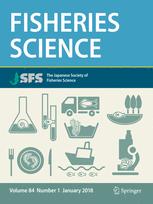
Fisheries Science is the official journal of the Japanese Society of Fisheries Science, which was established in 1932. Recognized as a leading journal in its field, Fisheries Science is respected internationally for the publication of basic and applied research articles in a broad range of subject areas relevant to fisheries science.
All articles are peer-reviewed by at least two experts in the field of the submitted paper. Published six times per year, Fisheries Science includes on average more than 180 articles per volume.
It has a rich history of presenting quality research in fisheries, biology, aquaculture, environment, chemistry and biochemistry, food science and technology, and social science. Separated from The Bulletin of the Japanese Society of Scientific Fisheries from Volume 60 in 1994.
| Language | English |
|---|---|
| ISSN | 0919-9268 (print version), 1444-2906(electronic version) |
| Publication | bi-monthly, 6 issues per year |
| Impact Factor |
1.4 (2023) |
| Publication Charges | The price per page is JPY 7,600 for non-members and JPY 4,000 for JSFS society members. |
Manuscript Submission Instructions for Authors Editorial Board
Browse Volumes & Issues
![]() Vol. 71 (2005) ~ Lastest Issue
Vol. 71 (2005) ~ Lastest Issue
Member OnlyMember can access freely to electrical version of Fisheries Science by input of the ID and pass distributed from secretary of JSFS.![]() Vol. 60 (1994)~ Vol. 70 & Vol. 68 Suppl.
Vol. 60 (1994)~ Vol. 70 & Vol. 68 Suppl.
ACADEMIC AREAS
- Fisheries: fishing technology, fish behavior, fishing ground, population dynamics, oceanographic conditions, acoustic and instrumentation, others
- Biology: taxonomy, morphology, physiology, ecology, nekton, benthos, plankton, seaweeds and seagrasses, others
- Aquaculture: food organisms, larval production, nutrition, grow-out, environment, diseases, breeding and heredity, others
- Environment: eutrophication, microorganisms, pollution, bio-accumulation, harmful plankton, others
- Chemistry and Biochemistry: proteins, enzymes, nucleic acids, lipids, sugars, extractive components, pigments, vitamins, biologically active substances, others
- Food Science and Technology: processing, preservation, food hygiene, microorganisms, others
- Social Sciences: sociology, economics, business management, law & politics, policy science, community development, cooperative, others
Editorial Office
The Japanese Society of Fisheries Science
Konan 4-5-7, Minato, Tokyo 108-8477, JAPAN
Email: fsjpubl@d1.dion.ne.jp
Phone: +81-3-3471-2165 Fax: +81-3471-2054
Articles Recommended
- [2024 AWARD WINNING PAPER]Efficacy of Bacillus spp. isolated from Nile tilapia Oreochromis niloticus Linn. on its growth and immunity, and control of pathogenic bacteriaFish Sci 86, 353–356 (2020)
- [2024 AWARD WINNING PAPER]Dietary supplementation of Chlorella vulgaris ameliorates chronic sodium arsenite toxicity in Nile tilapia Oreochromis niloticus as revealed by histopathological, biochemical and immune gene expression analysisFish Sci 85, 199–215 (2019)
- [2024 AWARD WINNING PAPER]Real-time glucose monitoring biosensor system assesses the effects of different environmental light colors on Nile tilapia stress responseFish Sci 90, 745–754 (2024)
- [2024 AWARD WINNING PAPER]What stock-per recruit target can be applied to Japanese fisheries resources under large uncertainties in the stock-recruitment relationship?Fish Sci 90, 687–700 (2024)
- [2024 AWARD WINNING PAPER]Inter-annual variation in the relationship between early growth rate and potential survival of the western sand lance Ammodytes japonicus in the Seto Inland Sea in western JapanFish Sci 90, 591–605 (2024)
- [2024 AWARD WINNING PAPER]Diets comprising hen egg yolk and milk proteins as potential alternatives to shark egg-based diets for larvae of the Japanese eel Anguilla japonicaFish Sci 90, 295–305 (2024)
- [2024 AWARD WINNING PAPER]Efficacy of octopus feed encased within a collagen membraneFish Sci 90, 257–267 (2024)
- [Review Article]Prospect of fluorescence fingerprints for the noninvasive sensing of seafood freshness: a reviewFish Sci 90, 339–356 (2024)
- [2023 AWARD WINNING PAPER]The effect of temperature on environmental DNA degradation of Japanese eelFish Sci 86, 465–471 (2020)
- [2023 AWARD WINNING PAPER]Evaluation of a single-cell protein as a dietary fish meal substitute for whiteleg shrimp Litopenaeus vannameiFish Sci 85, 147–155 (2019)
